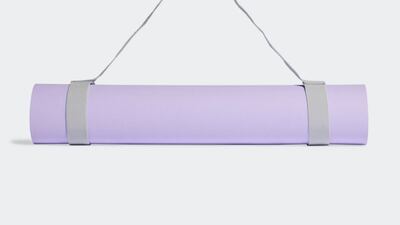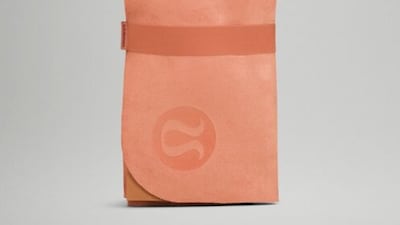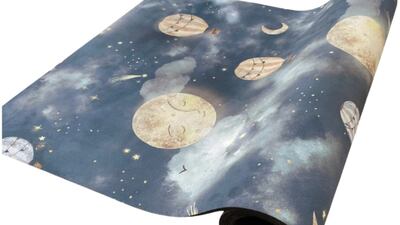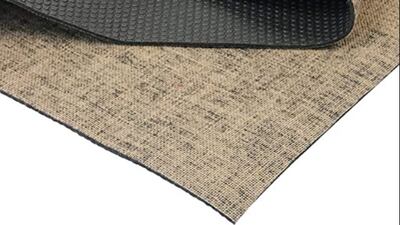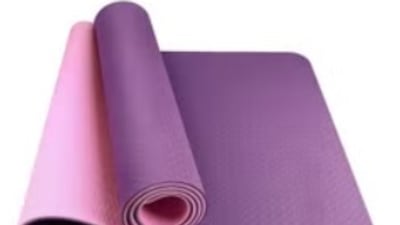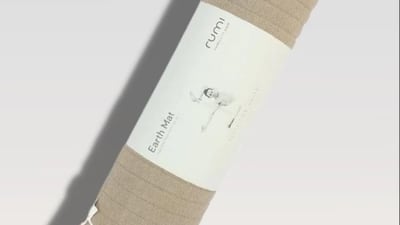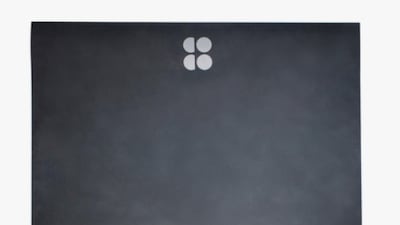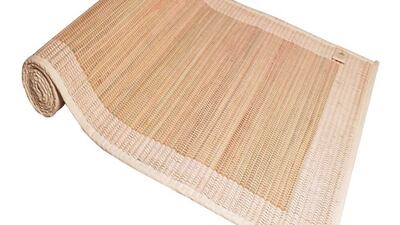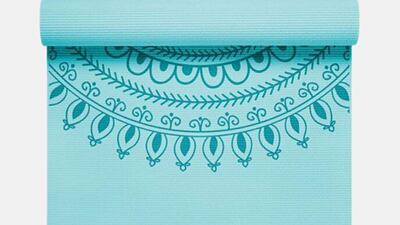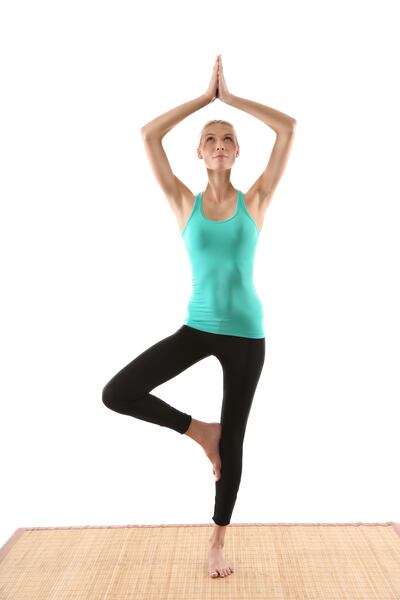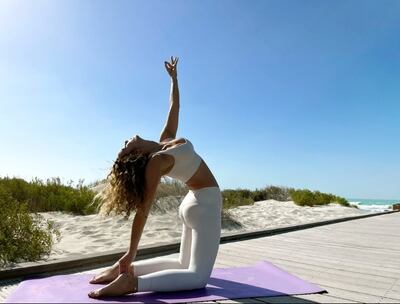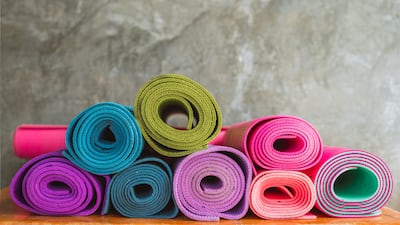With as many yoga mats on the market as there are yoga positions, it can be confusing to know which type to invest in.
To the untrained eye, most mats may look the same, but they differ in material, thickness, grip, size, weight and more, and choosing the right one is the best way to ensure you get the most out of your sessions. You also need to consider which variation of yoga you practise, the space you have available and any sensitivities or allergies to different materials.
“Buying a yoga mat is an important choice because it will support your practice, and help you enjoy it and get the best out of it,” says Angela Muller-Habig, yoga and Pilates instructor at Bodytree Studio in Abu Dhabi.
From rubber to cork, why materials matter
“Yoga mats are made from a variety of materials such as fibre-recyclable plastic, natural rubber, jute and cork,” says Shadi Enbashi, co-founder of Seva Holistic Wellness Centre in the UAE. “Fibre-recyclable plastic mats are environmentally friendly, provide excellent grip and are durable. Jute and cork mats are also eco-friendly and provide a good grip, but they may not be as durable as other materials.”
While PVC mats are the cheapest, they are also the most eco-unfriendly, and latex natural rubber mats are heavier and more expensive. Yoga mats were traditionally made of jute, which many practitioners prefer, and there are also biodegradable options.
“I own four mats, and choose among them according to the place where I practise yoga,” says Insiya Tinwala, a yoga instructor at Studio Sanjeev Krishna Yoga, Dubai. “Different materials have their own advantages and disadvantages. I wouldn’t want to use an expensive yoga mat on the beach, but rather a PVC cushioned mat, so I can have more grip and padding while holding postures.
“Cheaper mats are mostly made of artificial fibres and may have chemicals that are not good to breathe in when one lies on the stomach, so that’s when the cork mat is more beneficial.”
Different mats for different styles of yoga
Yoga mats vary in thickness to accommodate different types of yoga. Thinner mats are better suited for stability during active yoga disciplines such as ashtanga and vinyasa. Thicker mats provide extra cushioning and are designed for restorative, yin and hatha practices.
“If you’re looking for a more active style, you want a mat that is not super-thick, perhaps between 10mm and 35mm which will give you a bit of cushioning and enough stability to hold the more active poses and transition without feeling wobbly,” says Muller-Habig.
“If you have sensitive joints or you prefer a more restorative practice like yin, where you’ll be seated for longer periods of time, you might choose something more cushioned that provides more softness. However, it won’t be as stable if you’re balancing on one foot.”
When looking for a thicker mat, it’s recommended to spend more, as cheap materials will soften and thin out faster.
“Look out for the quality of materials used, durability, texture, thickness and size,” says Enbashi. “Expensive mats are often made with high-quality, sustainable materials that are more durable, and provide better grip and cushioning than cheaper mats.”
Tinwala adds: “If you are a beginner, I would suggest using a thicker mat as you are still learning how to balance, for which you need a better grip. Buy a textured mat made of PVC for better support and balance as it is also pocket-friendly.”
Mat maintenance
As with most exercise equipment, yoga mats needed to be cleaned, cared for and maintained, especially by practitioners who perspire a lot during sessions.
“Latex rubber is a premium mat and will last several years as long as you care for it properly. You can buy special cleaners for your mat, or clean it in the bathtub using a very mild soap before rinsing it well,” says Muller-Habig. “Let it dry in the shade, so the rubber doesn’t deteriorate.”
Yogis who wish to practise while on holiday or work trips can invest in a travel mat that packs up smaller and thinner to fit in a suitcase or carry-on.
“Ideally, if you are an avid yoga practitioner, you should have two yoga mats, a thicker one for regular practice at home, and a thinner one for travelling around,” says Enbashi.
Muller-Habig adds: “Travel yoga mats are usually made of latex rubber. I love this style as you can fold it like a carpet and take it everywhere with you.”
Race card
6.30pm: Maiden (TB) Dh 82,500 (Dirt) 1.600m
7.05pm: Maiden (TB) Dh 82,500 (D) 2,000m
7.50pm: Handicap (TB) Dh 82,500 (D) 1,600m
8.15pm: The Garhoud Sprint Listed (TB) Dh 132,500 (D) 1,200m
8.50pm: The Entisar Listed (TB) Dh 132,500 (D) 2,000m
9.25pm: Conditions (TB) Dh 120,000 (D) 1,400m
Killing of Qassem Suleimani
Wenger's Arsenal reign in numbers
1,228 - games at the helm, ahead of Sunday's Premier League fixture against West Ham United.
704 - wins to date as Arsenal manager.
3 - Premier League title wins, the last during an unbeaten Invincibles campaign of 2003/04.
1,549 - goals scored in Premier League matches by Wenger's teams.
10 - major trophies won.
473 - Premier League victories.
7 - FA Cup triumphs, with three of those having come the last four seasons.
151 - Premier League losses.
21 - full seasons in charge.
49 - games unbeaten in the Premier League from May 2003 to October 2004.
Labour dispute
The insured employee may still file an ILOE claim even if a labour dispute is ongoing post termination, but the insurer may suspend or reject payment, until the courts resolve the dispute, especially if the reason for termination is contested. The outcome of the labour court proceedings can directly affect eligibility.
- Abdullah Ishnaneh, Partner, BSA Law
THE BIO
Born: Mukalla, Yemen, 1979
Education: UAE University, Al Ain
Family: Married with two daughters: Asayel, 7, and Sara, 6
Favourite piece of music: Horse Dance by Naseer Shamma
Favourite book: Science and geology
Favourite place to travel to: Washington DC
Best advice you’ve ever been given: If you have a dream, you have to believe it, then you will see it.
Company Profile
Name: Thndr
Started: 2019
Co-founders: Ahmad Hammouda and Seif Amr
Sector: FinTech
Headquarters: Egypt
UAE base: Hub71, Abu Dhabi
Current number of staff: More than 150
Funds raised: $22 million
More from Neighbourhood Watch:
Company%C2%A0profile
%3Cp%3E%3Cstrong%3ECompany%20name%3A%20%3C%2Fstrong%3ELeap%0D%3Cbr%3E%3Cstrong%3EStarted%3A%20%3C%2Fstrong%3EMarch%202021%0D%3Cbr%3E%3Cstrong%3EFounders%3A%3C%2Fstrong%3E%20Ziad%20Toqan%20and%20Jamil%20Khammu%0D%3Cbr%3E%3Cstrong%3EBased%3A%3C%2Fstrong%3E%20Dubai%0D%3Cbr%3E%3Cstrong%3ESector%3A%20%3C%2Fstrong%3EFinTech%0D%3Cbr%3E%3Cstrong%3EInvestment%20stage%3A%20%3C%2Fstrong%3EPre-seed%0D%3Cbr%3E%3Cstrong%3EFunds%20raised%3A%3C%2Fstrong%3E%20Undisclosed%0D%3Cbr%3E%3Cstrong%3ECurrent%20number%20of%20staff%3A%20%3C%2Fstrong%3ESeven%3C%2Fp%3E%0A
UAE currency: the story behind the money in your pockets
Traits of Chinese zodiac animals
Tiger:independent, successful, volatile
Rat:witty, creative, charming
Ox:diligent, perseverent, conservative
Rabbit:gracious, considerate, sensitive
Dragon:prosperous, brave, rash
Snake:calm, thoughtful, stubborn
Horse:faithful, energetic, carefree
Sheep:easy-going, peacemaker, curious
Monkey:family-orientated, clever, playful
Rooster:honest, confident, pompous
Dog:loyal, kind, perfectionist
Boar:loving, tolerant, indulgent
Wicked: For Good
Director: Jon M Chu
Starring: Ariana Grande, Cynthia Erivo, Jonathan Bailey, Jeff Goldblum, Michelle Yeoh, Ethan Slater
Rating: 4/5
Joker: Folie a Deux
Starring: Joaquin Phoenix, Lady Gaga, Brendan Gleeson
Director: Todd Phillips
Rating: 2/5
Moonfall
Director: Rolan Emmerich
Stars: Patrick Wilson, Halle Berry
Rating: 3/5
UAE players with central contracts
Rohan Mustafa, Ashfaq Ahmed, Chirag Suri, Rameez Shahzad, Shaiman Anwar, Adnan Mufti, Mohammed Usman, Ghulam Shabbir, Ahmed Raza, Qadeer Ahmed, Amir Hayat, Mohammed Naveed and Imran Haider.
BMW M5 specs
Engine: 4.4-litre twin-turbo V-8 petrol enging with additional electric motor
Power: 727hp
Torque: 1,000Nm
Transmission: 8-speed auto
Fuel consumption: 10.6L/100km
On sale: Now
Price: From Dh650,000
The specs
- Engine: 3.9-litre twin-turbo V8
- Power: 640hp
- Torque: 760nm
- On sale: 2026
- Price: Not announced yet
The specs
Engine: Dual 180kW and 300kW front and rear motors
Power: 480kW
Torque: 850Nm
Transmission: Single-speed automatic
Price: From Dh359,900 ($98,000)
On sale: Now
Groom and Two Brides
Director: Elie Semaan
Starring: Abdullah Boushehri, Laila Abdallah, Lulwa Almulla
Rating: 3/5
WITHIN%20SAND
%3Cp%3EDirector%3A%20Moe%20Alatawi%3C%2Fp%3E%0A%3Cp%3EStarring%3A%20Ra%E2%80%99ed%20Alshammari%2C%20Adwa%20Fahd%2C%20Muhand%20Alsaleh%3C%2Fp%3E%0A%3Cp%3ERating%3A%203%2F5%3C%2Fp%3E%0A
Specs
Engine: 51.5kW electric motor
Range: 400km
Power: 134bhp
Torque: 175Nm
Price: From Dh98,800
Available: Now
Education reform in Abu Dhabi
The emirate’s public education system has been in a constant state of change since the New School Model was launched in 2010 by the Abu Dhabi Education Council. The NSM, which is also known as the Abu Dhabi School Model, transformed the public school curriculum by introducing bilingual education starting with students from grades one to five. Under this new curriculum, the children spend half the day learning in Arabic and half in English – being taught maths, science and English language by mostly Western educated, native English speakers. The NSM curriculum also moved away from rote learning and required teachers to develop a “child-centered learning environment” that promoted critical thinking and independent learning. The NSM expanded by one grade each year and by the 2017-2018 academic year, it will have reached the high school level. Major reforms to the high school curriculum were announced in 2015. The two-stream curriculum, which allowed pupils to elect to follow a science or humanities course of study, was eliminated. In its place was a singular curriculum in which stem -- science, technology, engineering and maths – accounted for at least 50 per cent of all subjects. In 2016, Adec announced additional changes, including the introduction of two levels of maths and physics – advanced or general – to pupils in Grade 10, and a new core subject, career guidance, for grades 10 to 12; and a digital technology and innovation course for Grade 9. Next year, the focus will be on launching a new moral education subject to teach pupils from grades 1 to 9 character and morality, civic studies, cultural studies and the individual and the community.
About RuPay
A homegrown card payment scheme launched by the National Payments Corporation of India and backed by the Reserve Bank of India, the country’s central bank
RuPay process payments between banks and merchants for purchases made with credit or debit cards
It has grown rapidly in India and competes with global payment network firms like MasterCard and Visa.
In India, it can be used at ATMs, for online payments and variations of the card can be used to pay for bus, metro charges, road toll payments
The name blends two words rupee and payment
Some advantages of the network include lower processing fees and transaction costs
Essentials
The flights
Return flights from Dubai to Windhoek, with a combination of Emirates and Air Namibia, cost from US$790 (Dh2,902) via Johannesburg.
The trip
A 10-day self-drive in Namibia staying at a combination of the safari camps mentioned – Okonjima AfriCat, Little Kulala, Desert Rhino/Damaraland, Ongava – costs from $7,000 (Dh25,711) per person, including car hire (Toyota 4x4 or similar), but excluding international flights, with The Luxury Safari Company.
When to go
The cooler winter months, from June to September, are best, especially for game viewing.
Specs
Engine: Dual-motor all-wheel-drive electric
Range: Up to 610km
Power: 905hp
Torque: 985Nm
Price: From Dh439,000
Available: Now
Silent Hill f
Publisher: Konami
Platforms: PlayStation 5, Xbox Series X/S, PC
Rating: 4.5/5
Monster
Directed by: Anthony Mandler
Starring: Kelvin Harrison Jr., John David Washington
3/5
COMPANY%20PROFILE
%3Cp%3E%3Cstrong%3EName%3A%3C%2Fstrong%3E%20Floward%0D%3Cbr%3E%3Cstrong%3EBased%3A%20%3C%2Fstrong%3ERiyadh%2C%20Saudi%20Arabia%0D%3Cbr%3E%3Cstrong%3EFounders%3A%20%3C%2Fstrong%3EAbdulaziz%20Al%20Loughani%20and%20Mohamed%20Al%20Arifi%0D%3Cbr%3E%3Cstrong%3ESector%3A%20%3C%2Fstrong%3EE-commerce%0D%3Cbr%3E%3Cstrong%3ETotal%20funding%3A%20%3C%2Fstrong%3EAbout%20%24200%20million%0D%3Cbr%3E%3Cstrong%3EInvestors%3A%20%3C%2Fstrong%3EAljazira%20Capital%2C%20Rainwater%20Partners%2C%20STV%20and%20Impact46%0D%3Cbr%3E%3Cstrong%3ENumber%20of%20employees%3A%20%3C%2Fstrong%3E1%2C200%3C%2Fp%3E%0A
UFC Fight Night 2
1am – Early prelims
2am – Prelims
4am-7am – Main card
7:30am-9am – press cons
